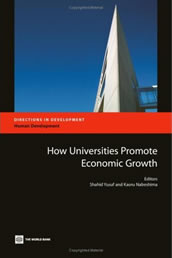BOOK REVIEW
HOW UNIVERSITIES PROMOTE ECONOMIC GROWTH
By Shahid Yusuf and Kaoru Nabeshima (Editors)
Washington: World Bank Publications, 2006. 286 pp (incl
index),
$30.00. ISBN - 10: 0-8216-6751-X

Download options |
 |
|
DOI: 10.2966/scrip.050108.218 |
||
With flourishing prognostications about an impending global knowledge economy, it would be well neigh impossible to disagree with Samuel Johnson’s averment that “[t]he future is purchased by the present.” Being as we are on the brink of entering a mature era dominated by knowledge, can universities, as creators of knowledge, be isolated and complacent? There is a growing section of literature that has been recognising the positive impact universities can have on the local / regional economy by improving the region’s human capital in addition to aiding firms in commercialising inventions. This book too belongs to this genre of economic literature that advocates University-Industry Links (UILs). Yusuf and Nabeshima, both from the World Bank, have brought together seventeen essays that “examine the role of university in enhancing technological capability…and to discuss the policy measures being applied…” [Preface].
When Humboldt emphasised the need for research activities in universities a few centuries ago, he was looking beyond a teaching-learning centric institution, and wanted universities to flower into centres of knowledge production. The contemporary pressures of a globally interlinked economy have forced universities and business firms alike to come out of their straitjacketed positions and work together, for innovation is the lynchpin for survival. Universities require money to sustain themselves and firms need new ideas that transcend disciplines. The result was UILs that serve as “a vehicle for supporting, if not accelerating, technological development” [p.7]. In addition to jointly working with industry, UILs define public space functions like conducting conferences and meetings that ensure transfer of knowledge and room for debate.
With only two essays from the business community, the book is titled in favour of the academic justification for linking with industry. The predictable role of UILs for a university is to produce skilled workers on one end and on the other, to engage in commercialisation of technology developed at the university. The entrepreneurial university is a more proactive entity that is innovation-driven and aims to create and hold global talent, as well as generate revenue for further research. It is the joint operation of the projects/ businesses that ensure sustainable spin-offs for the entrepreneurial university. Particular cases in China and Singapore are mentioned.
Given individual differences among nations, no essay has been so daring to advocate a uniform policy of UILs. Thus, the readers are treated to case studies from nations of Asia, Europe and North America. UK and USA are fortunate in that both nations have a centralised scheme for innovation. The former’s Science and Innovation Investment Framework 2004-2014 offers a long term approach to fostering innovations within the nation, while the latter’s Bayh-Dole Act of 1980 encourages universities to work in tandem with industry. Other nations, however, do not have this advantage. For instance, in Japan, it was public pressure that made universities more industry-friendly, whereas in India, the highly diverse models of UILs have been due to the lack of an institutional regime. The essay by Alan Hughes on UK (Ch.6) and by Rakesh Basant and Pankaj Chandra on India’s UILs (Ch.13) need mention for their clarity and the guidance they offer. The other essays too warrant attention, but they fall short, in a few ways, of paving the way for future action.
One issue that stands out prominently from the book is the need for synchronised functioning among the government (policies), the business units (funds and opportunities) and the universities (talent and infrastructure). Every nation need to have a vision about the innovation and the technological progress that it aims to achieve, and the impact such a vision statement will have on the well being of the people. Consequently, designing a National Innovation Policy takes precedence over short term incentives like tax benefits for R&D, subsidies for education and research or quotas for students. The model for UILs must encompass research, training, consultancy and technology transfer. This will create positive externalities like industry clusters, employment opportunities and raising the innovative capacity of the nation.
There is guidance and assurance in this book. However, the authors do not throw enough light on the hurdles that come on the way to achieving UILs. Apart from the essay on India, there is hardly any mention of the social impact of UILs. Also, not much can be gathered from two essays by the representatives of the industry. Besides, if one is looking at any empirical studies on university impacting GDP numbers, as the title might suggest, this is not the right place for it. This book, then, can serve as additional material on the existing literature on making universities and industries come together with the support and nurturance of the state. In this way, it is a useful document.
G
Narasimha Raghavan
PhD Candidate
Dept of Economics
PSG College of Arts and Science
Coimbatore
Tamil Nadu State
India
DOI: 10.2966/scrip.050108.X
© G Narasimha
Raghavan 2008

This work is licenced under a
Creative Commons Licence.
Please click on the link to read the
terms and conditions.
